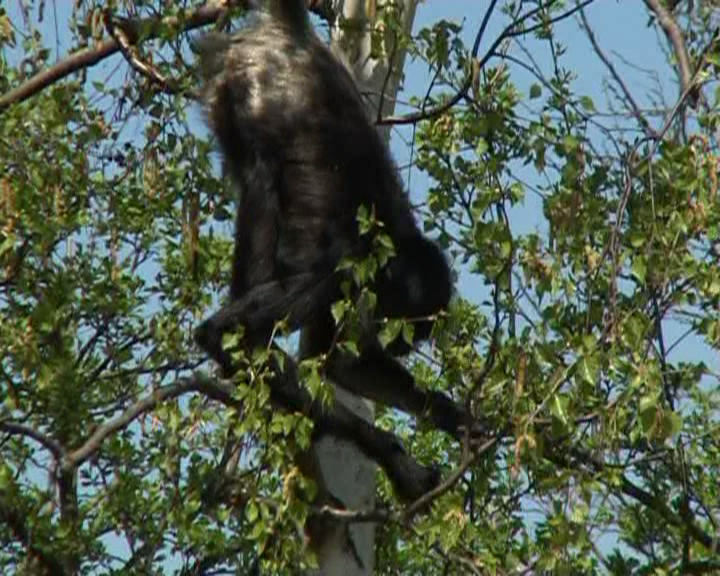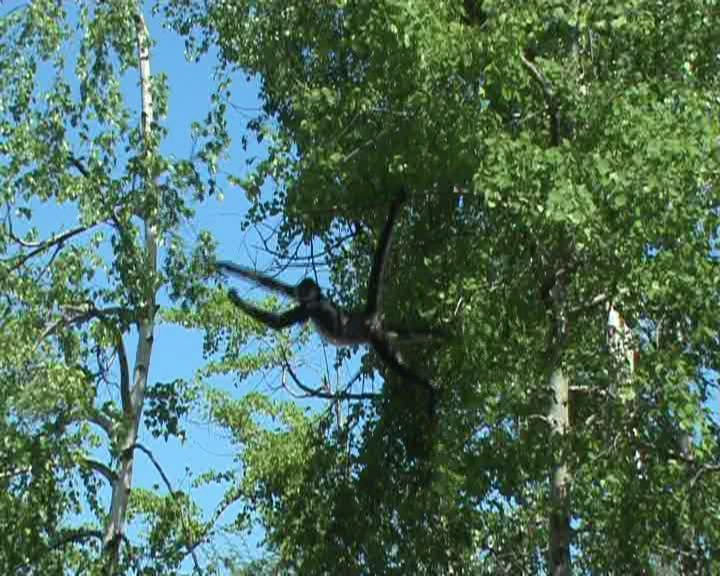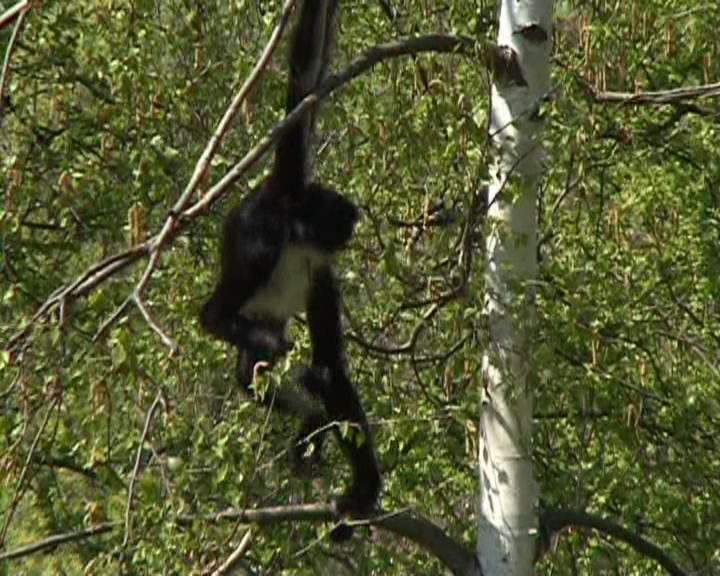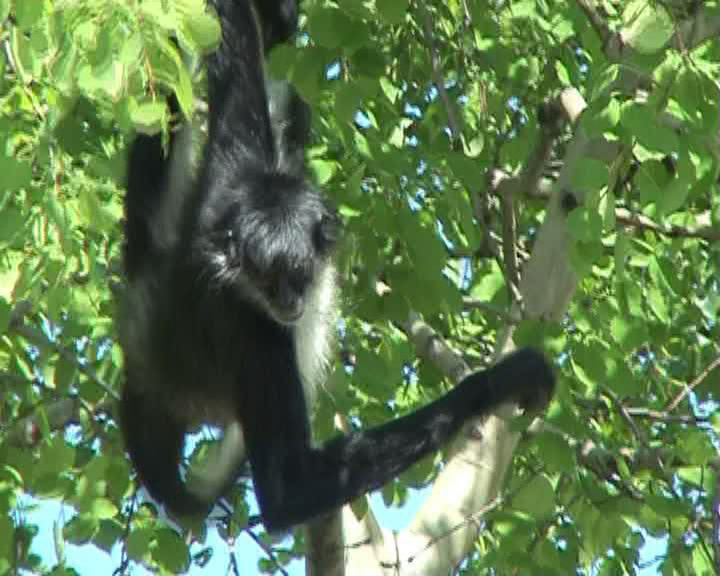MAREK WASILEWSKI – The Polish Forest
Agata Araszkiewicz
Exoticism and birches
When the Dutch artist, Ruud van Empel, showed his “photographic painting” in 2004 which depicted a small Caucasian girl, with blond hair and a fair dress, in an amazingly green forest (untitled), he was immediately accused of creating a paradise for fascists. In response to these accusations, the artist, after long months of tedious work with Photoshop software created the World (2005-2006), containing portraits of black children in an abundant exotic jungle.
The Sunday clothes and poses in an absolutely western style gave them a colonial trait (“the white girl” emphasizes it beautifully). The tacky colours idealized both types of images, tinting them with a bit of exaggerated sentimentality. However, in the context of this “photographic painting” such notions as “innocence” and “nature” sound like an accusation. In this stylistic excess there seems to be room for subversion, the childlike easiness creates a political difficulty. To think about it, despite the mawkish setting it is quite impossible not to notice the tribute paid here to history, the history of abolitionism and the history of oppression of slaves and children. The intended gesture to “clash” the two forests – the exotic one with the simple birch grove – casts a shadow over the possible question about Eden. The history is more of a paradise fallen. [1]
The seemingly innocent video work by Marek Wasilewski “The Polish Forest” („Polski las” (2006) is just as surprising in its revealed political trait. The artist catches here one of the most important topos of Polish national and insurgent mythology. “I would not refuse shelter to a feminist walking out of the woods”- wrote Jerzy Pilch in one of his essays for the Polityka monthly, when commenting the tensions in young Polish democracy. The characteristic substitution of an insurger /partisan with the figure of a feminist serves as proof that the discourse of activism is a tradition in Polish culture and that it has not ceased to be needed. The forest is still one of the most important places in Polish collective – and intimate – imagination.
I have once quoted a story of a friend of mine whose parents had given her a birthday present of a plot of woodland of a few square kilometres. [2] She went there with her son but got lost. Twenty kilometres one way, twenty the other, she finally reached a road sign saying, “Treblinka 20 km”…Interestingly enough, another Polish (or rather Polish-French) painter of woods, Adam Adach, upon his first visit to Treblinka also got lost in the maze of trees, planted there by the Nazis so as to conceal their crime. The painting Untitled (Treblinka) (2004) shows just the information sign, hidden in the green.
After the works of Adach the landscape of Central Europe – the Polish forest – will never be innocent again. “Birches (birke in German) haunt his canvasses” – wrote Le Figaro after one of the artist’s exhibitions, – “the birches, which we have forgotten, gave Birkenau its name”. In the Birke painting (2005) the grove of trees with a specific white bark is seen as an emblem. They are no longer a memory of our childhood holidays but a synonym of the kitsch element in idyllic paintings (the typical “noble stag in the sunset” is like the forest child portraits of Ruud van Empel). The German birkenau is birch grove in Polish. As the German critic, Alexander Pühringer, stresses in his essay „Bouleau et mémoire” (“The Birch and Memory”) [3] – the woods in the paintings of the Polish artist Adach is a subtle reply to the question of Adorno: is art possible after Auschwitz?
All of us born here, whether we like it or not, from the childhood years deal in our imagination with the memory of this crime, even if it was not us who have committed it. The new century has brought about new historical studies and debates on the topic which had been forbidden in Poland for many years. Our collective memory has still not yet found an answer to the question how to find closure to mourning and how to locate the memory of the victims of Holocaust. Even if we do that, however, the Holocaust will always be coming back in the form of monuments of dislocated memory. The time of hasty answers has not yet come [4]. Remaining in a conscious “ignorance”, consenting to lost innocence, seeking emblems of possible collective memory, designating more fully the places of mourning “save” the chance for our metaphysical and historical orientation.
According to traditional symbols, birches mean the ritual of purification. In his short story “Brzezina” (The Birsh Grove) Jarosław Iwaszkiewicz (1933) captured the typically modernist myth of connecting sexuality with death – the motive of the “fallen” desire which crystallizes itself in the face of agony. The film adaptation by Andrzej Wajda (1970) tells the story of a young man who returns to his birthplace – among birches – to die of a terminal disease but also to live his one last romance. This “story of pure fate” by the most famous Polish director, the founder of national imagination and the last heir of the romantic myth is truly exceptional in his body of work. Interestingly enough, Wajda has never made a film which would “settle accounts” with the Holocaust – such films come from abroad: “Schindler’s List” by Spielberg or Polanski’s “The Pianist”. When I was a small girl I had always thought that “The Birch Grove” was about insurgents….
There is yet one other issue related to the story by Iwaszkiewicz, that being the fact of hiding homosexual desire, so typical of that cultural epoch. We can feel it in “The Birch Grove”. Similar to Thomas Mann’s “Death in Venice” (1912), the Freudian characters of Eros and Thanatos are to maintain the order of “inexpressibility” with regard to what must not be expressed. The modernist Iwaszkiewiczian youths, suffering from romantic unfulfillment are the literary proof of lack of political consent to the emancipation of homosexual desire.
This is a history long gone in Western Europe. In Poland, where “the sexual war” [5] is still on, this is unfortunately still the presence. Hence “the birch grove”, as the imaginary topos subject to constant reinterpretation, can be the place of a purifying change in Polish culture.
I think the reason why the birch-rich “Polish Forest” in Marek Wasilewski’s video work is so intense, sensuous, and mysterious is because it steams with the weight of these meanings, accompanied by an intellectual and ironic situation, which is the best legacy of Tomas Mann. Among the mellow green trees which could hide the phantasms of partisans, there swings an animal most exotic of all…a monkey. From the times of Breugel, a monkey in painting, iconography and western representations was a colonial, if ambivalent, cliché of the exotic until it gained the status of The Stranger in Jane Goodall’s anthropology. Perhaps it was also due to the later discoveries by Darwin that a presentation of a monkey was also often a deconstruction – after all this is how Wisława Szymborska sees the medieval image in her famous poem “The Two Monkeys of Breugel” (1957) (as is similar – in its expression of alleged equality between the civilized and the savage – “King Kong”, the popcultural blockbuster). The “ridges of the world” are expanding today. Exoticism is no longer a styled expression of wild desire – such things have been pushed out. We are all exotic now.
Just as “exotic” seems to be Polish contemporary public life, or rather its fossilized epigonic remains left over from the Romantic myth. In a sense it could be said that Polish cultural war is about the friction between two options: the absolutely dominating first option which would like to see the Polish forest constantly full of partisans and stay faithful to the glorious sacrificing martyrological tradition, and the second option which is modern and in minority, which would be happy – fearless of the greenhouse effect – to see the birches standing next to, say, the palms of Jerusalem…We lack the sun of the South – writes Maria Janion, the most important chronicler and deconstructionist of the Polish Romantic paradigm6. In her essay “A Farewell to Poland”, showing the tragic loss of Polish patriotism in times of European freedom, she says, “Poland – in spite of the wishful thinking and hypocritical assurances – is not a multicultural country. It is a poor and flat monolith – usually Nationalist Catholic.(…) The racket of the warriors for God, Honour, Homeland ” drowns out any other broader understanding of a Polish community, where there is room for ethnic and sexual minorities. The national romantic mythology which was obligatory thus far has become impoverished, an end has come to the traditional understanding of what is Polish. It is necessary to renew the spiritual identity of the nation. It would be possible to endure here, even without the sun of the South, if our culture was more diverse, liberated from colonial and post colonial obsessions, but also if it was colourful. This is what is expressed by the formula of “A Farewell to Poland”, its traits seen both is the mass scale emigration for financial reasons, as well as in contemporary literature and art.
Wasilewski seems to be a partisan fighting for this new spiritual ideal, for this post-Polish rebirth. Complementary to the installation by Joanna Rajkowska of the famous palm tree in Aleje Jerozolimskie (a street in Warsaw – Avenue of Jerusalem – from the translator) made as tribute to the Jews once living in the district – a “colourful” monkey swings head down from Marek Wasilewski’s birch (this film frame symbolizes the work on the cover of the invitation). We do not know exactly where the film was shot and whether the monkey is genuinely Polish, as what is important here is the order of imagination, a possible dream of the Polish paradise where there is room for otherness. Just as the figure of a partisan/insurger is important for the myth of independent Poland, the martyrology of which must be questioned, so are the contemporary characters of a feminist, a homosexual, and committed artist – in recognition of the truths they propagate – indispensable for freedom in the Poland of today.
The monkey in the birch grove created by Wasilewski is a peculiar equivalent and a contemporary completion of “Monkey in the Bath”, a nursery rhyme by Aleksander Fredro (the most civil of all Romantic poets, still awaiting genuine recognition). Quoting, in rough translation:
Happy monkey to be daring
When a human she could mimic
Seeing once her mistress bathing
Waited quietly to play her gimmick
When the mistress left, door closing
Prankster simian quickly posing
In her lady’s morning top
Into the bathtub she hops!
Off she starts to turn the taps
To the left and right she snaps
Up and down, in all that hype…
Boiling water from the pipe!
Warm and pleasant, heaven-like
Monkey thinks, ”That’s what I like!”…7
Everywhere there is a monkey there are dreams of paradise, although in this case the story does not have a happy end (the animal starts drowning in boiling water only to escape in the last minute)… In the “Polish Forest” it is not the monkey that tries to mimic somebody in its aspiration for identity. It is us, more likely, who should mimic the monkey so as to escape the bad ending. We should create, strengthen, invigorate and respect the Polish right to otherness.
A famous Polish political journalist and one of the patrons of Polish transformation after 1989, Adam Michnik, used to jokingly say, “it’s not my circus, it’s not my monkeys”. With years, however, it turned out that both the circus and the monkeys were his…. The skill of self-questioning should probably be one of the most important ones for Poles now. I would very much wish for our mini-colonial vision of Africa – the nursery rhyme “Bambo, the Negro Boy” – to resemble more the portraits by Ruud an Empel, which also undermine “white representations”. I once called the memorable murals by Tomek Kozak entitled “Poles! Just One More Effort!” (2004) depicting “the excluded” from the Grottgerian version of a group of Kościuszko’s insurgents (a mother with a child, a Jew, and a Bolshevik) “a satire of Polish hell”8. Let Wasilewski’s “Polish Forest” be an attempt at a “Polish paradise”. After all, this birch grove with monkeys can be a Polish paradise. But will it?
Paris, May 2007
1. Anna Sansom, Paradis artificiel, ”Mixte” No 45, April 2007, pp. 66-67
2. In the essay Haunted by Smoke (Nawiedzani przez dym), ”Czas Kultury” No 6/2003
3. Alexander Pürhinger, Bouleau et mémoire, catalogue to the exhibition in Nice ”Adam Adach”, Musée National Marc Chagalle, Réunion des Musées Nationaux, Nice, 14 October – 14 November 2005
4. As ”hasty” a response to the issue of Holocaust I see the work 8064 by Artur Żmijewksi, in which he re-tattoos a former Auschwitz prisoner. According to the interpretation of the author himself, the Holocaust remains an individual Jewish case, there is no stranger living in us and the memory can be returned only at the sacrifice of victims. Żmijewski looks at the Holocaust from the position of “innocence”. I believe that the artist who “opened up” this topic in Polish art but who perhaps too hastily tried to have it “judged” wants to “purify” and comprehend “something” which cannot be thus comprehended. See: Artur Żmijewski, Agata Araszkiewicz, Let’s Talk About ”8064”, ”Obieg” On-line magazine No1/2005
5. An expression by Paweł Leszkowicz, see: P. Leszkowicz, Why homosexuality? The sexual war in Poland and crisis of human rights (Dlaczego homoseksualizm? Wojna seksualna w Polsce i kryzys praw człowieka), ”Zeszyty Artystyczne” No 12, June 2004
6. Maria Janion’s essay Farewell to Poland initially published in ”Krytyka Polityczna” No 6/2004 has been reprinted as To Part With Poland in the book The Incredible Slavdom (Niesamowita Słowiańszczyzna), Wydawnictwo Literackie, 2007
7. The original fragment quoted by the author in Polish is somewhat different from the original (from the translator).
8. A. Araszkiewicz, Terytoria polo-mena, ”Obieg” on-line magazine, March 2005
Curator: Monika SzewczykMarek Wasilewski

PLAN YOUR VISIT
Opening times:
Thuesday – Sunday
10:00-18:00
Last admission
to exhibition is at:
17.30



